In Stock and Custom Order Handpans for sale
What is a Handpan, Hang Drum, and Pantam?
The “handpan”, “Hang Drum”, “pantam”, and “UFO Drum” are different names for a closely related family of relatively young musical instruments. The instrument is made of two convex sheets of steel glued together. They have tuned notes on the top and sometimes bottom half that can be played with the hands.
Each instrument is tuned to a single scale such as Major, Minor or Harmonic Minor. No understanding of music theory is required to create beautiful music because there are no wrong notes in the single scale. This also allows a player to improvise from a more emotional and kinetic inspiration free of the mind. Many players use these instruments for person meditation, sound healing as well as more traditional group compositions.
Each high quality instrument has notes with tuned harmonics that can be individually played as well a tuned hole in the bottom shell that creates a playable helmholtz like an udu drum. Some builders have called this hole a “port” or “gu”.
The overtone rich instrument has an ethereal and hypnotic sound that emanates in all directions and often captivates listeners.
History of the Hand Pan, Hang Drum, and Pantam
When and where was it invented?
The path of this instrument’s development has traveled the globe and is intimately related to other musical instruments some of which are also very young and some of which are centuries old.
Most people agree that the founders of the handpan are Felix Rohner and Sabina Schärer of PANArt Hangbau AG in Bern, Switzerland. The two were career steel pan builders as well as inventors of multiple other musical instruments. Felix started building steel pans in Switzerland in 1976 and supplied many of the instruments for the steel bands that arose in the country in the 1980’s and 1990’s.
In the late 1990’s, Reto Weber, a hand percussionist, came to Felix and Sabina and had the idea for changing a steel pan into a “sounding pot in steel with some notes to play with the hands”. The idea was to mix the sound of the South India Ghatam with the sound of a steel pan. After some experimentation, Felix and Sabina had birthed the “mother Hang”, which can be found in the foreground of the following photo (courtesy of wikipedia). Additionally, there is a ghatam in the bottom right corner and Hang Hang (plural for Hang) fabricated in 2005 (top right), 2006 (top middle) and 2007 (top left).
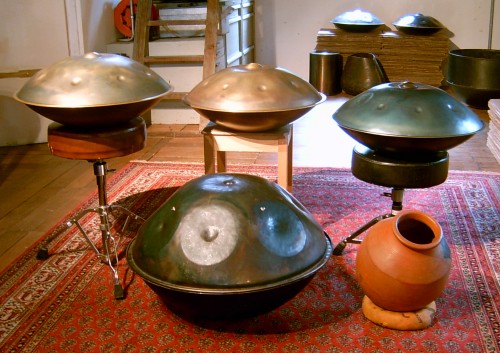
The word “Hang” came from the Bernese German word for “Hand”. The instruments became commonly referred to as Hang Drums, which is still a very commonly used phrase today even though its use has been strongly discouraged by PANart.
PANart Hang Production
Felix and Sabina stopped steel pan production and in 2001, they started fabricating the First Generation Hang Hang. One can be seen in the photo above in the top right. In the same year, they presented the instrument at Musikmesse Frankfurt. From 2001 to 2005, they offered the instrument in approximately 45 different sound models, which were focused mostly on ethnic musical scales like Ake bono, Hijaz, Pygmy, Melog and Zhi Diao. The instruments all had 8 notes in a circle around a center note, which they referred to as the “ding”. Felix and Sabina reportedly made over 5000 first generation Hang Hang.
The First Generation Hang was mostly sold by select distributors around the world. In 2005, the popularity of the instrument skyrocketed when people began finding videos of them on youtube. We still hear the same words today from people new to the art form: “I saw this video of this amazing instrument and knew I just had to have one”.
When PANart moved on to crafting the Second Generation Hang and eventually the Third Generation Hang, the process of obtaining one became increasing difficult. PANart began requesting that every prospective buyer send a hand written letter explaining their motivations and desires for purchasing the instrument. Buyers would then wait for months and often years without a response in hopes that they would be contacted and invited to purchase a Hang in person in Bern Switzerland.
During Hang Production, PANart published a number of great documents about tuning, design, material, and forming methods that can be found HERE.
“Further collaboration between art and science is needed to make it possible that other hang makers may exist in the future.” – Felix Rohner – 2007
Is the Hang a Handpan?
PANart has said many times that the Hang is not a handpan or a steel pan. They explain that the Hang is tuned in ways that are not used in the tuning of handpans or steel pans particularly in regards to note structure and architecture. This has been directly challenged however by one of the top authorities on the steel pan, Anthony Achong, author of “Secrets of the Steel Pan, Unlocking the Secrets of the Science, Technology, Tuning and Operation of the Steel Pan”. Achong bluntly states at the end of this commentary directly in response to PANart’s claim: “The Hang is a Steelpan (Pan) having limited musical range (low registers only) because of the chosen method of direct hand playing.”
Additionally, multiple handpan builders have explored and utilized the tuning techniques, architectural designs, and shell forming techniques published by PANart in the creation of their own handpans and pantam instruments. Some handpan builders even base their entire design on emulating as closely as possible the original design and sound of the Hang.
Overwhelmingly, most people consider the Hang, handpan, and pantam to be the same family of instruments while of course each company has its own brand name. We generally refer to the Saraz as a Handpan, however our customers have called them “Handpans”, “Hang Drums” and “Pantams”.
Before the PANart Hang
Early History of the Steel Pan
The Hang was far from being a completely new creation. In Achong’s words quoted above, it is actually a modified steel pan. So it is important that we also consider the significant steps that lead to the development of the steel pan when talking about the history of the Hang, handpan or pantam.
First and foremost, we must consider Trinidad and Tobago, the birth place of the steel pan. On these islands, musical instruments were outlawed during the early 1900’s. In rebellion, the locals began finding different things to drum on. With oil production being so important on the island, it was not long before the locals began banging on the oil drums. After awhile, some people started shaping the drums to produce a number of different tones on the same drum. Years later, the young Ellie Mannette, who is widely regarded as the father of the modern day steel pan, spent years developing the oil drum into a musical instrument. When Mark Garner met him in 2012, Ellie said “I wanted to be able to play Mary had a little lamb or any other song on the steel pan”. Those earliest instruments were tuned by ear while being shaped in the mosquito filled swamps of Trinidad before the “Pan Yards” became increasingly common on the island for steel pan production. The following image is an early photograph of young Ellie and the Oval Boys at work in 1944. (Photo Courtesy of the endless talented Andy Narell)
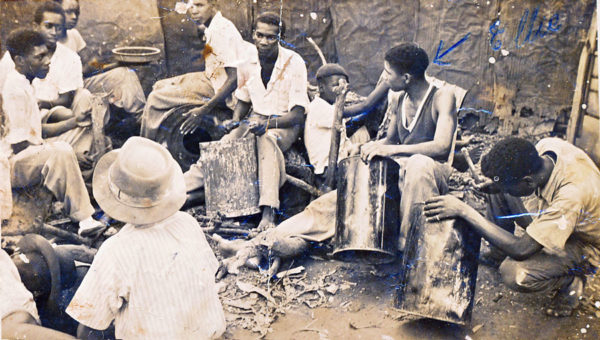
In those days, Ellie was focused primarily on tuning only the fundamental frequency of each note as he helped refine the only new acoustic instrument invented in the 20th century. The following video gives insight into the process and history while interviewing the man himself.
“Looking back more than half a century during my humble beginnings in this unique art form, no one during that period could have envisioned the rapid growth of this instrument. Through the years as I developed my skills, my entire mindset was sharing my knowledge with others for the betterment of this instrument.” – Ellie Mannette
On a side note
Before the first Saraz had been birthed in 2012, Mark Garner traveled the world to seek out and watch some of the finest handpan and Steel Pan builders he could find including Ellie Mannette. Mark was deeply honored to spend some time with Ellie and watch over his shoulder while he tuned a lead steel pan. Even at the age of 84, he was an absolute fire ball that was still endlessly passionate about singing steel. In the following photo, Mark is introducing Ellie to the Halo Handpan, crafted by Pantheon Steel. The building style and design was unlike anything Ellie had ever seen before on singing steel. Mark has said that “the experience felt like bringing one of Ellie’s grand children to meet him for the first time.”
Ellie Mannette passed at the age of 90 on August 29th, 2018. We are endlessly thankful to Ellie for his amazing lifetime of contributions and dedication to singing steel. We are all here because of him.
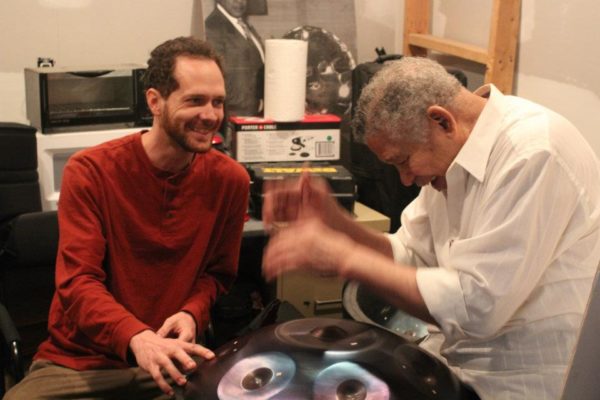
The Steel Pan Matures
After years of refinement by not only Ellie but also Winston Spree Simon, Anthony Achong, and many many others, the instrument continued to develop. From what we have heard, it was in the 1960’s that the first person started tuning an octave harmonic along with the fundamental frequencies on each note. After another 10-15 years, it became more common that the highest quality steel pan builders were also tuning another frequency on what developed as a shorter axis perpendicular to the octave axis. This third frequency eventually became the compound 5th, which can be found on high quality steel pans and handpans. Still today, there are both steel pan and handpan builders that tune frequencies that are a 2nd, 3rd or 4th scale degree of the octave on the short axis, however this leads more to a note with a sound that “cries” and results in what is generally regarded as a lower quality instrument. There is a magic in the primary harmonic ratio of a Fundamental, Octave, and Compound 5th.
The 1:2:3 frequency ratio in Steel Pan and Handpan notes
If we consider basic wave physics, the fundamental is one wave, which could be represented as the top layer in the following diagram. The octave is exactly 2 waves that equal the same length as the fundamental, which can be represented as the second layer in the diagram. The compound 5th is exactly 3 waves that equal the same length as the fundamental, which can be represented as the third layer in the diagram. This 1:2:3 ratio is the most basic harmony possible and is perhaps responsible for some of the magic of both the steel pan and the handpan sound.
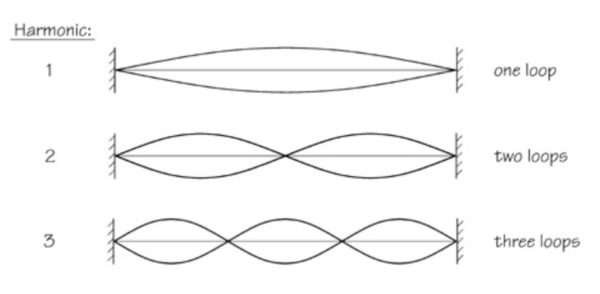
Tuning more Frequencies in the Steel
In the 1990’s, the top steel pan builders such as Ellie Mannette began tuning additional frequencies in the edges of larger notes. These are more commonly referred to as “shoulder tones” today. On the early steel pans with tuned shoulder tones, typically the tuner achieved a second octave harmonic. For example, if it was an E3 fundamental note with an E4 octave harmonic on the long axis, then the shoulder tone would ideally be an E5. The second octave has exactly 4 loops in the same space as the one loop of the fundamental.
While we have seen a few early Hang with shoulder tones that were quite close to in tune, the first handpan builder to consistently and intentionally tune shoulder tones specifically on the center note was Victor Levinson, creator of the SPB. Ezhan of Echo Sound Sculpture wasn’t far behind. Mark Garner began learning about shoulder tone tuning in 2013. Mark and Josh have been tuning shoulder tones on the center note of the Saraz since 2015. Currently, we estimate that less than 10% of today’s handpan and pantam builders are able to tune the shoulder tones on their instruments while even less take the extensive time and effort to do the challenging job.
History of the Gong and Gamelan Instruments
Handpan, Hang and pantam technology is very similar to the steel pan as the two are tuned and constructed with incredibly similar variables, however, there are other influences that are also quite influential on the handpan. Another significant influence is the central dome structure of gongs and some Gamelan instruments. These dome structures date back hundreds of years on both instruments. The dome structure was also being utilized by PANart in the 1990’s to control the upper partials of the membrane for a warmer and more controlled tone and timbre on their steel pans. It was a natural transition for PANart to use the same structure when first developing the Hang. Much more about the dome structure, its history and use on handpans can be found HERE.
Where did the names “Handpan”, “Pantam”, UFO Drum originate?
“Handpan”
Not long after the Hang was being distributed, other people started trying to build them. We have heard that Marco Della Ratta was the first person to try building a similar instrument as early as 2002 or 2003. Around 2007, Kyle Cox and Jim Dusin of Pantheon Steel, Luis Martin Eguiguren Garrido of Bellart, and Philippe Maignaut of Spacedrum were each trying to build similar instruments. When more people started building these modified steel pans, PANart publicly stated that they did not want the trademarked term “Hang” or “Hang Drum” to be used for everyone’s instruments and that instead that term should be reserved only for their specific instrument. This was at the same time as a rather significant rift on Hangblog.org, who also stated that the blog was specifically for the Hang, which was built by Panart. Not long afterward, Handpan.org was started with the name being coined by Kyle Cox of Pantheon Steel.
“It was evident that the originators did not want their trademarked name to be used as a generic term so one had to be invented. Since the mother art form of steel pan originated in Trinidad & Tobago, I respectfully sought to include the word ‘pan’. Since it is played by ‘hand’ it seemed quite obvious that we should call it a ‘handpan’.” – Kyle Cox
“Pantam”
The term “pantam” was originally used by an Israeli PANart Hang Distributor to describe the Hang. The term is a mix of steel pan and ghatam, the later of which is a clay pot drum from Southern India. The term “pantam” found a resurgence of popularity when Victor Levinson, the creator of the SPB, started using it in 2014 to describe his own instruments. Many builders and players have since followed while the terms “Handpan” and “Hang Drum” are still considerably more popular.
“UFO Drum”
This term seemed to be a result of people trying to figure out what the instrument was called while searching online for the name. The shape of the instrument no doubt looks similar to preconceived ideas of a unidentified flying object with aliens inside. 😉 Even today, we very commonly hear people say “it looks like a UFO” when we introduce them to the instrument for the first time. Very rarely do we hear people actually use this name for the family of instruments however.
Which term to use today?
Today, handpan, Hang Drum, and pantam are used interchangeably by many players and even some builders to describe not only these types of instruments but also tongue drums. Some builders prefer that their instruments are called one of these specific names while many other builders simply do not care. For now, google trends shows that by far the term “Hang Drum” has dominated for years, however “handpan” has become equally popular since early 2017. These two are by far the most popular terms. The 2018 spike of the term “pantam” is closely related to the release of the “Pantam Stand“, which is an instrument stand for handpan, Hang, pantam and tongue drums. Perhaps in 100 years, one of the names will dominate. More on this topic can be found HERE.
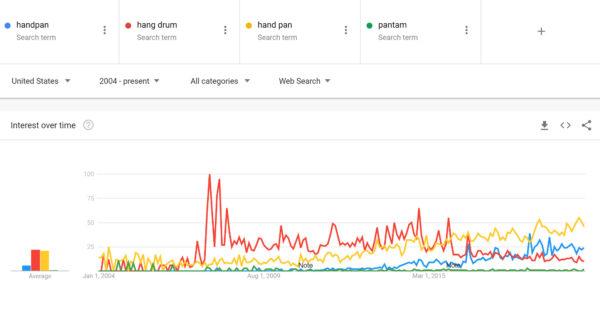
Is the Hand Pan, Hang and Pantam a “Drum”?
Technically speaking, no, it is not specifically a drum in the proper acoustic physics usage of the word. The handpan, Hang, and pantam are considered technically part of the idiophone class of musical instruments. Most percussion instruments that are not drums, are actually idiophones, which produce sound by the entire instrument as a whole vibrating. Drums are technically membranophones that operate by a stretched material vibrating when being hit with a mallet or hand or when excited by friction or plucked.
Why are handpans, pantam and Hang called “drums”?
The simple reason is because this is the term that most people including musicians commonly use to refer to many types of percussion instruments. Terms like idiophone and membranophone are very rarely used and even less commonly understood. Imagine you are trying to figure out the name of the amazing instrument that PANart made, which is called the “Hang”. You search online for the word and find a wide array of search results however none of them have anything to do with the Hang or handpans. This is effectively why the term “Hang Drum” became so popular.
Many of today’s most cutting edge handpan, Hang and pantam players are using techniques directly borrowed from frame drum and tabla playing techniques or rhythms used on conga, djembe and drum set. The popularity of these instruments specifically with drummers and percussionists only further bridges the gap between these words however technically incorrect they are actually being used.
End of the PANart Hang
In 2014, PANart discontinued the production of the Hang in order to focus on new instruments including the Gubal, Gudu, HangBal, Pang Strings and other instruments from their Pang Material.
Exponential Explosion of Hand Pan Builders
While many people miss the Hang and were disappointed by the end of production, it has inspired a new generation of builders to dive into the latest chapter of tuned steel. Some of them have picked up where PANart and steel pan builders have left off while others are exploring new possibilities. This new generation of builders have continued to develop and evolve the art form further with more notes on the instrument, novel layouts, improved stability, additional tuned frequencies like shoulder tones, new shell forming methods and exploration of alloys that don’t require nitriding for rust resistance. Players and builders mostly agree that the instrument is still very young in its development and there are still far more directions of possible evolution.
The Saraz Hand Pan, one of the Earliest Builders
When the Saraz Handpan was born in 2012, there were 4 other builders crafting medium to high quality instruments and about 10 people world wide making anything resembling a handpan however poor of quality it may have been. We have watched and helped grow the art form exponentially since that time. Mark Garner, the founder of Saraz, was one of the first people world wide to start publicly and extensively sharing his building experiences and hard earned lessons on Handpan.org and in Facebook builder groups. We have helped a number of other builders get started on their own journey with the hammer and also enjoyed the synergy of them coming back later and sharing new ideas with us.
We also salute some of the other early pioneers that have help cultivate and foster the art form. First is of course PANart, who published a number of great papers on the topic. Kyle Cox and Jim Dusin were first to sell equipment and tools for making handpans. Also Matthieu and Delphine of Shellopan were the first to offer nitrided deep drawn handpan shells to other builders. In combination with their building workshops, Matthieu and Delphine have helped unleash a new generation of builders. Additionally, Ayasa has also started offering deep drawn shells and other equipment. Without these people, the world might still be where it was in 2012 when Mark and all of the other early builders learned primarily from trial and error how to not only tune but develop and design high quality handpans.
The Changing Hand Pan Market
When Saraz started production in 2012, there was an absolutely insatiable demand for anything even close to a handpan. Completely out of tune junk regularly sold for over $2000 USD on ebay. Even tongue drums were in high demand in those days and often had waiting lists. We turned down thousands of people in the first 3 years of production simply because we could not even consider trying to keep up with the demand of people that wanted a Saraz.
Over the years however, more and more builders have started crafting beautiful instruments. This is starting to bring balance to the supply and demand of the art form. Up until 2016, it was common to see second hand instruments flipped for thousands of dollars more than their retail price. However in recent years, these second hand prices have come down significantly. Hang that once sold for $10,000 – 12,000 rarely now sell for much more than $5,000 if even that much.
In 2018, current estimates state that there are over 300 public builders of these instruments with more people being inspired every day to pick up the hammer. This means that is now easier than ever before to find and purchase a handpan.
A Word of Caution
While there are more and more people creating instruments, one must still be careful and do their research before purchasing an instrument. We have seen over and over again when someone purchases a cheap instrument from ebay or amazon only to contact us afterward and ask if we can tune it (or finish building it) because it is a poorly tuned unstable instrument.
There are a number of great handpan builders in the world today. Make sure to purchase one from a reputable builder that is highly regarded. While there are more handpans than ever before, that means that there are also more poor quality handpans than ever before. Be aware that even some of the highest ranking companies on google search results produce some of the lowest quality instruments available. Even some of the highest ranking sites that recommend certain builders are focused entirely on poor quality builders that are giving them a commission to advertise. Seriously, do your research!
Magic of the Hand Pan, Hang and Pantam
There is a magic contained in these musical instruments. Perhaps it is the ratios of inherent harmony in each note or it is the novelty of sing steel to the human ear that touches people. Perhaps is the ease of playing in one scale and composing from a more emotional and kinetic inspiration. Perhaps there is simply something magical about these instruments that goes beyond comprehension and understanding and speaks to us somewhere more deeply in our hearts and spirits. What ever the source of this magic may be, the handpan is here to stay. It has a long path of continued development ahead of it for many more decades and maybe centuries into the future.







